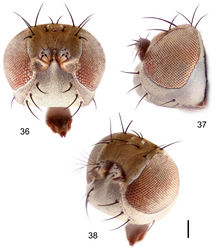Hydrochasma sinuatum
| Notice: | This page is derived from the original publication listed below, whose author(s) should always be credited. Further contributors may edit and improve the content of this page and, consequently, need to be credited as well (see page history). Any assessment of factual correctness requires a careful review of the original article as well as of subsequent contributions.
If you are uncertain whether your planned contribution is correct or not, we suggest that you use the associated discussion page instead of editing the page directly. This page should be cited as follows (rationale):
Citation formats to copy and paste
BibTeX: @article{Mathis2013ZooKeys363, RIS/ Endnote: TY - JOUR Wikipedia/ Citizendium: <ref name="Mathis2013ZooKeys363">{{Citation See also the citation download page at the journal. |
Ordo: Diptera
Familia: Ephydridae
Genus: Hydrochasma
Name
Hydrochasma sinuatum Mathis & Zatwarnicki, 2013 sp. n. – Wikispecies link – ZooBank link – Pensoft Profile
- Hydrochasma species Mathis, 1997:182 [review, Belize].
Diagnosis
This species is distinguished from other congeners by the following combination of characters: Small shore flies, body length 1.50–1.95 mm. Head: Antenna mostly dark gray; parafacial silvery white, concolorous with facial coloration; gena-to-eye ratio 0.18–0.20. Thorax: Wing with costal vein ratio 0.75–0.76; M vein ratio 0.47–0.49. Forecoxa whitish gray to gray. Hindtibia with prominent ventroapical, shallowly curved, spur-like seta. Abdomen: Tergites broadly slate gray medially, lacking wedge-shaped, gray to silvery gray areas laterally; tergite 5 of male gray with faint brown lateral margins, concolorous with tergites 2–4. Male terminalia (Figs 39–42): Combined structures generally moderately elongate, in posterior view height less than twice width (1.83×), dorsal half with setulae twice length of those on ventral half; epandrium with dorsal arch above cerci narrowly connected, in posterior view (Fig. 39) with dorsal margin arched, dorsal half as wide as high, apical half as 2 elongate, narrow, almost parallel sided processes, each oriented slightly medially, forming a deep, medial incision, in lateral view (Fig. 40) with anterior margin conspicuously sinuous, widest ventrad of cercus with a notch-like incision at base of ventral epandrial extension, ventral epandrial extension slightly tapered to rounded apex; cerci moderately elongate, height nearly twice width in posterior view, mostly semi-hemispherical (Fig. 39); aedeagus in lateral view (Fig. 42) elongate, narrow, nearly straight, length about 4× width, tubular, in ventral view (Fig. 41) shallowly emarginate at base, mostly parallel sided on basal half, apical half tapered to narrowly rounded apex; phallapodeme in lateral view (Fig. 42) narrowly elongate, keel very shallow and short, barely evident, in ventral view (Fig. 41) an elongate T with arms very short and thin, perpendicular; gonite in lateral view (Fig. 42) very narrowly elongate, bar-like, nearly straight, in ventral view (Fig. 41) as a robust, short comma; hypandrium in lateral view (Fig. 42) elongate, thin, very shallowly arched, in ventral view (Fig. 41) with elongate, narrow, lateral processes, each slightly more than half length of aedeagus, anterior margin shallowly incised, incision shallowly bifurcate.
Type material
The holotype male of Hydrochasma sinuatum is labeled “BELIZE. Stann Cr[ee]k. Dist[rict]. MullinsRiver[,] (17km N Dangriga)[,] 29 March 1988, Wayne N. Mathis/USNM ENT 00285977 [plastic bar code label]/HOLOTYPE ♂ Hydrochasma sinuatum Mathis & Zatwarnicki, USNM [red].” The holotype is double mounted (minuten in a block of plastic), is in excellent condition, and is deposited in the USNM. Fifteen paratypes (6♂, 9♀; USNM) bear the same label data as the holotype.
Type locality
Belize. Stann Creek: Mullins Creek (17 km N Dangriga; 17°06.2'N, 88°17.8'W).
Other specimens examined
Neotropical. BELIZE. Stann Creek: Dangriga (16°58'N, 88°13'W), 3–4 Apr 1993, W. N. Mathis (18♂, 8♀; USNM); Silk Grass Creek (16°58'N, 88°13'W), 3 Apr 1993, W. N. Mathis (1♂, 1♀; USNM); Twin Cays, Aanderaa Flats (16°50'N, 88°06'W), 17–21 Mar 1988, W. N. Mathis (1♀; USNM); Twin Cays, West Bay (16°50'N, 88°06'W), 22 May 1988,W. N. Mathis (1♂; USNM).
COSTA RICA. Guanacaste: Santa Cruz (14 km S; 10°10.4'N, 85°35.7'W; 180 m), 23 Jun 2001, W. N. Mathis (1♂; USNM).
HONDURAS. Cortés: Omoa (16°47.8'N, 87°58.4'W), 26 Sep 1995, D. and W. N. Mathis (2♂, 2♀; USNM).
MEXICO. Sinaloa: Concordia (13 km NE; 23°20.7'N, 105°58.4'W), 15 Aug 1960, P. H. Arnaud, Jr., D. C. Rentz, E. D. Ross (7♂, 12♀; CAS, USNM).
PERU. Madre de Dios: Río Manu, Erika (near Salvación; 12°50.7'S, 71°23.3'W; 550 m), 5-6 Sep 1988, A. Freidberg, W. N. Mathis (2♂, 1♀; USNM).
Distribution
(Fig. 43). Neotropical: Belize (Stann Creek), Costa Rica (Guanacaste), Honduras (Cortés), Mexico (Sinaloa), Peru (Madre de Dios).
Etymology
The species epithet, sinuatum, is of Latin derivation and means winding or bent, referring to the shape of the extended epandrium in lateral view.
Remarks
Although structures of the male terminalia of this species are similar to those of Hydrochasma digitatum, they consistently differ in detail. This is particularly evident in the shape of the ventral, epandrial processes where in lateral view there is a basal, posterior notch, and the processes themselves are sinuous and not shallowly arched, as in Hydrochasma digitatum. The sinuous profile of the ventral, epandrial process is the basis for the name of this species.
Original Description
- Mathis, W; Zatwarnicki, T; 2013: A revision of the shore-fly genus Hydrochasma Hendel (Diptera, Ephydridae) ZooKeys, 363: 1-161. doi
Images
|

![Figures 39–42. Hydrochasma sinuatum sp. n. (Mexico. Sinaloa: 13 km NE of Concordia) 39 epandrium and cerci, posterior view 40 same, lateral view 41 internal structures of male terminalia (aedeagus [shaded], phallapodeme, gonite, hypandrium), ventral view 42 same, lateral view. Scale bar = 0.1 mm.](https://species-id.net/o/thumb.php?f=ZooKeys-363-001-g016.jpg&width=167)
